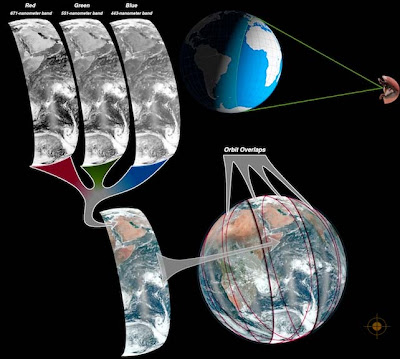
How were these highly thorough imagery created? The satellite flies 512 miles on top of the Earth, but the images appear as if they were taken from a much higher perspective: an altitude of 1,242 for the first image and 7,918 miles for the second. This little trick was accomplished by stitching together data from several orbits, creating an image that appears to be “pulled back.”
NASA launched the 4,600-pound Suomi in October to remotely sense variations in the Earth’s oceans, continents, and atmosphere and get a better understanding of climate change. It passes directly from pole to pole 14 times a day, imaging 1,865-mile swaths of our planet with each trip.
On board Suomi, the Visible Infrared Imaging Radiometer Suite (VIIRS) instrument takes pictures in red, green, and blue wavelengths. For the whole-Earth images, those wavelengths were combined to create a natural color photograph. It is not an exact representation of what an observer sitting in space would see, because particles in the atmosphere scatter short wavelengths of light, and our planet would actually appear more blue-tinged. The photos more accurately portray how the oceans and continents appear from the ground.
Oceanographer Norman Kuring, who compiled the two pictures, said the original image, showing North and Central America, was made as a favor to project scientist James Gleason who was looking for an ocean color image to show in a presentation. Word got out of the striking picture and NASA officials released it on Jan. 25, resulting in 3 million people viewing it in one week.
NASA launched the 4,600-pound Suomi in October to remotely sense variations in the Earth’s oceans, continents, and atmosphere and get a better understanding of climate change. It passes directly from pole to pole 14 times a day, imaging 1,865-mile swaths of our planet with each trip.
On board Suomi, the Visible Infrared Imaging Radiometer Suite (VIIRS) instrument takes pictures in red, green, and blue wavelengths. For the whole-Earth images, those wavelengths were combined to create a natural color photograph. It is not an exact representation of what an observer sitting in space would see, because particles in the atmosphere scatter short wavelengths of light, and our planet would actually appear more blue-tinged. The photos more accurately portray how the oceans and continents appear from the ground.
Oceanographer Norman Kuring, who compiled the two pictures, said the original image, showing North and Central America, was made as a favor to project scientist James Gleason who was looking for an ocean color image to show in a presentation. Word got out of the striking picture and NASA officials released it on Jan. 25, resulting in 3 million people viewing it in one week.